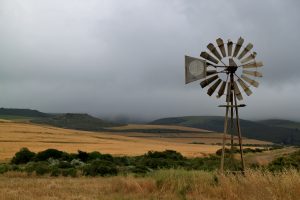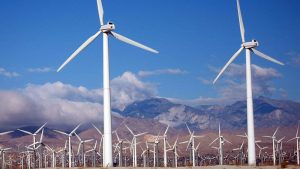
(Note: Only the single page link in bold font on this page is essential reading for the exercise. There is, however, a required internet search in bold font. The links in a regular font are optional but may be useful depending on your own background.)
In rural North America, isolated windmills that use wind power to pump water up from an aquifer into a stock tank have long been part of the landscape. Those windmills are usually about 25 feet tall and have an 8-foot wheel. By comparison, modern turbines in wind farms are over 200 feet tall, and their blades are 150 feet long. They’re getting steadily taller, with longer blades, in an effort to capture more of the passing wind energy as well as winds at higher levels in the air. Wind turbine placement in wind farms is getting thicker (more turbines at closer spacing) for the same reason: it increases the efficiency with which the passing wind is harvested so that less wind passes through the field of turbines uncaptured. At present, there are 57,000 wind turbines in the US and more windfarms are planned off-shore and in many locations worldwide.

The First Law of Thermodynamics is that energy is never either created or destroyed; it simply changes from one form to another. In practical terms, this means the energy in moving wind that turns the blades of a windmill is no longer available to move the air itself. So wind diminishes (since wind IS moving air). The energy in the part of the wind that moves the turbine blades changes from energy due to motion (kinetic energy) to electrical energy as it goes through the turbine inside the structure. Most of the energy that’s involved in that conversion doesn’t make it to the end point of electrical energy, however, but is instead released into the environment as waste heat. Waste heat is always produced in any process of energy transfer or change of form, and only about 30% of the energy in the wind that turns a turbine blade is converted to electricity. The other 70% is released as waste heat. (This low efficiency level is normal for energy transfer.)
Once energy that has been “harvested” by the windmill changes form by moving the turbine blades, it is no longer available to move the air as wind. That energy has been harvested and is now gone from the atmosphere. Some of it has been converted to electricity and a great deal has been converted to waste heat. Wind farms are put in locations where the winds are strong, as those are places a lot of energy is moving through the air. Winds move clouds and masses of cold or warmed air (“fronts”). Some of the critical winds for moving warm and cool air masses are at high altitude, but the relationships between the different types of winds that move air masses at different levels of the atmosphere are not yet well understood even though it’s known they are connected in complex ways.
One of the impacts of climate change presently being observed is an apparent slowing of wind speeds. (A PDF of this NASA report is here in case the link breaks.) As a result, tropical cyclones are stalling out more than they used to and hurricanes are causing far more flood damage from rainfall alone than they used to. Even some storms that aren’t hurricanes have become slow-moving, and some stay in place for such a long time that rain falls steadily for many hours as the rain clouds form and re-form in place. Severe flash floods that killed 21 people in the state of Tennessee in the summer of 2021 happened because “storms kept redeveloping as they moved and went over the same areas repeatedly, resulting in upwards of 3 to 4 inches of rain per hour.” More than 17 inches of rain wound up falling in a single place over less than 24 hours.
Questions for your process:
Why do you think I’m assuming that wind turbines might have something to do with changing wind patterns, given that there’s no direct evidence in the things you’ve read?
Do an online search for “heat deaths in cities” and skim several of the articles that come up so you get some idea of the nature of this problem and the role played by heat domes. If winds are diminished in significant ways, how might that impact summer heat domes over urban areas?
How do you think RFTO (robustness-fragility trade-off) might play into the issues of large wind farms and wind-related problems such as stalled storms, increased flooding, and long-term urban heat domes?
How might the height, blade size, and density of wind turbines impact their ability to change winds and therefore large-scale weather patterns?
Wind turbines are expensive to build and operate, and their construction and manufacturing requires a lot of resources. But if energy costs remain high, they are cost-effective. That is, wind turbines are a solution to energy problems when what’s considered is the bottom line (which you can see here, in itemized detail, in the blue box near the bottom of the page ). How might this itemized business view of wind turbines relate to the lack of attention being paid to diminished wind speeds or air mass movements, as well as to possible impacts such as stalled storm systems that drop catastrophic amounts of rain and cause floods?
How do wind farms fit into the redrawn economies diagrams? What about on the second diagram I made of the tallgrass prairie in the Flint Hills, that shows relationship between the wind and everything else that’s part of this ecosystem? What do the ethics of wind farms look like through a lens of Indigenous worldview?
What are the cultural or political problems you’d face in trying to assess the impact of large wind farms on global or regional wind speeds?
Has thinking about these questions changed your perception of my assumption that wind turbines might have an impact on wind patterns?
How does the idea of Knowledge being patient, rather than panicked, play into all of this?
Why do you think I titled this page “Mining the Wind”? How does it change the way we see solar farms and wind farms if we say we are mining the sun and the wind?
Does thinking about this page and those on Mining the Land and Mining the Sun change any of your earlier responses on those two other pages? Why or how so — or why or how not?
When you’ve finished thinking through these things and written your responses, please go to the next page to start exploring Winter. But before you go, I remind you a last time that I absolutely am NOT arguing for continued use of carbon-based energy sources in these pages. Instead, I’m trying to point to one of the biggest problems facing contemporary people today: unnecessarily dualistic “either/or” energy solutions that focus on what type of energy to use without including additional considerations such as how much energy to use. Either/or duality forces people into making choices that trade one destructive and non-sustainable “solution” for another because the real underlying problem — in this case, that we use unsustainable amounts of energy — is never seen or addressed.
